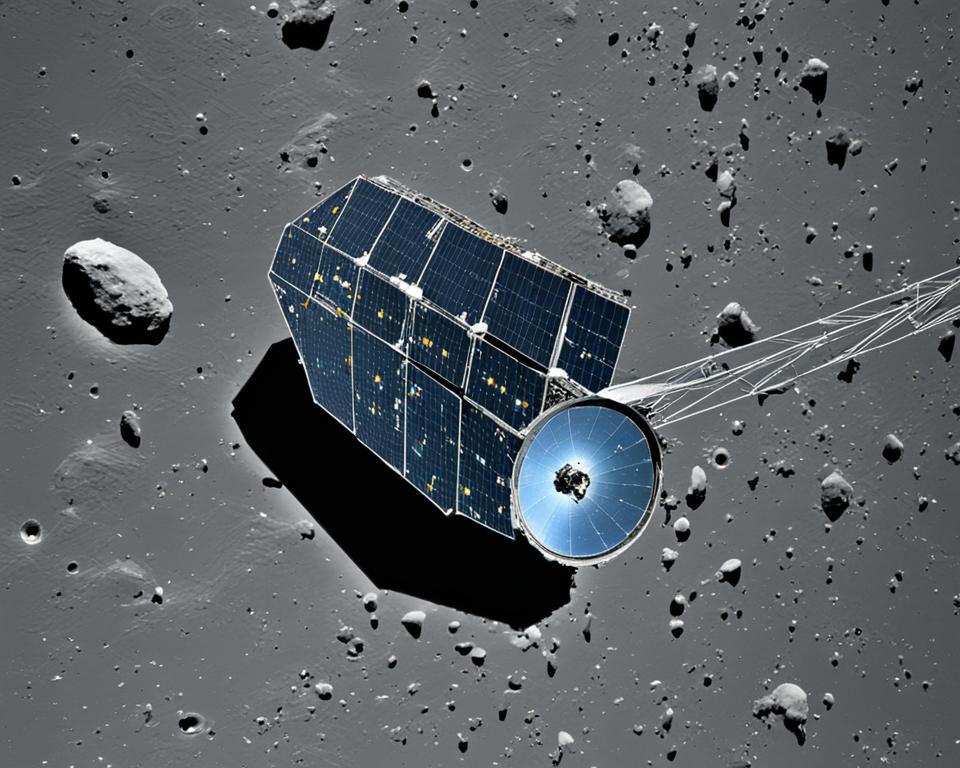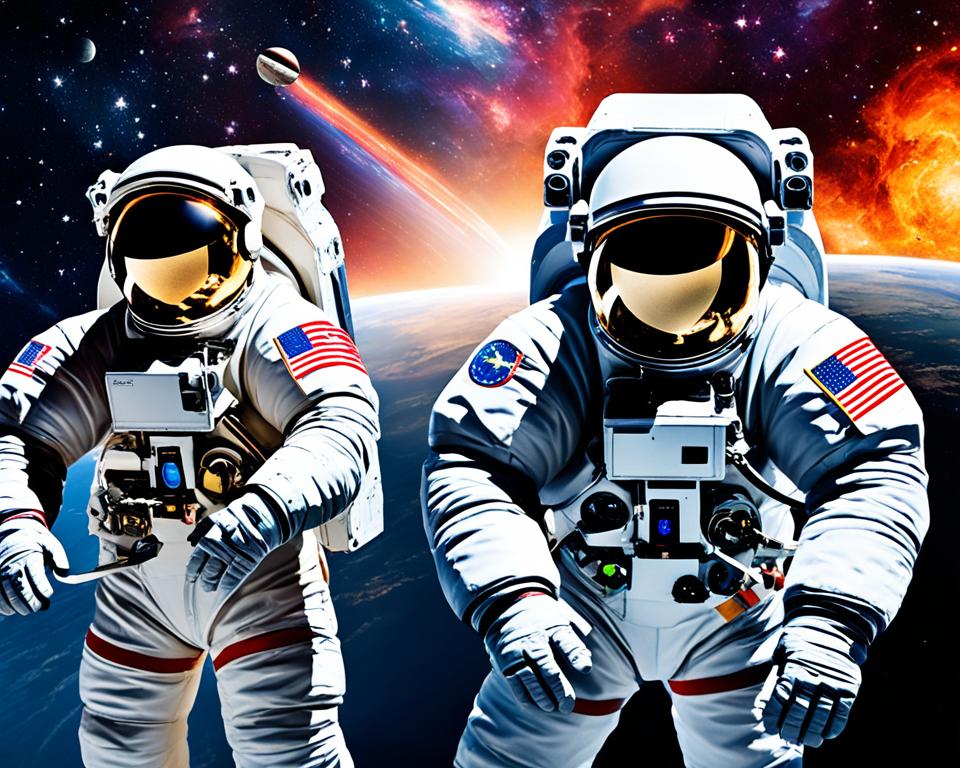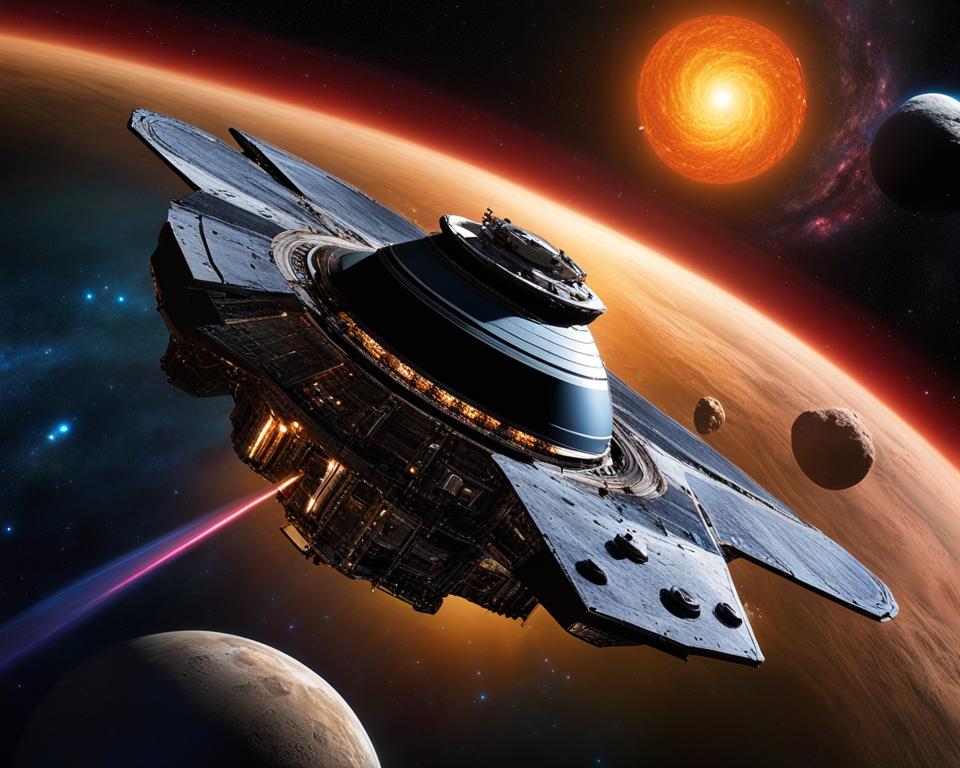Adverts
Have you ever stopped to think about the wonders of space that lie beyond our sight? A Parker Solar Probe mission, one space probe developed by NASA, allows us to explore the universe in a unique way. With the approximate size of a compact car, this probe will perform 24 orbits around the sun, providing valuable information about the solar winds and the space weather that impact Earth and other planets.
Adverts
One of the most impressive aspects of this mission is how close the Parker Solar Probe will reach to the sun. At about 5.2 million kilometers from the solar surface, the probe will be closer to the sun than any other spacecraft has ever been. This proximity will allow NASA scientists to study solar phenomena and better understand how these events affect our planet and the space around us. It's as if we are witnessing the hand of god in space.
To ensure the probe's protection against intense radiation from the sun during the mission, the Parker Solar Probe has a state-of-the-art thermal shield made of carbon. This shield is capable of withstanding extreme temperatures, reaching around 2,500 degrees Fahrenheit. Furthermore, the probe uses solar energy as a source of energy during space exploration. This means it can harness the sun's energy to stay active during long journeys through space.
Adverts
O launch of the Parker Solar Probe is scheduled for July 31, 2018, from Cape Canaveral, Florida. The probe is named Eugene Parker, in honor of the scientist who hypothesized that the sun constantly emits high-speed matter and magnetism that affect the planets and space in our solar system. This mission is a major achievement for space exploration and takes us one step closer to unlocking the secrets of the universe.
Main points covered in this article:
- Parker Solar Probe Mission and the probe size
- Probe orbits around the sun
- A hand of god in space and the solar energy
- Probe protection against solar radiation
- O launch of the Parker Solar Probe and named after Eugene Parker
The Discovery of Pluto by the New Horizons Mission
A New Horizons mission was responsible for revealing unprecedented images of Pluto, one of the most distant planets in the Solar System. The first images sent by the probe showed unexpected formations on Pluto's surface, surprising scientists.
A Venus Express probe mission it was also an important space exploration. She provided the first images of the planet Venus, revealing surprising characteristics, such as its dense atmosphere and extremely high temperature.
Another outstanding mission was the Galileo probe, which explored the Jovian system. It brought important discoveries about Jupiter and its moons, such as the intense volcanic activity of Io and the impact of pieces of comet Levy-Shoemaker with the planet.
These space missions have expanded our knowledge about the mysteries of space and the functioning of the celestial bodies in our Solar System.
See too:
First Images of Pluto Sent by New Horizons
“It was a surprising discovery. The formations on Pluto's surface were completely unexpected and revealed a geologically active world.” – Scientist at New Horizons mission.
| Mission | Planet | goal |
|---|---|---|
| New Horizons | Pluto | Explore and send never-before-seen images of Pluto |
| Venus Express | Venus | Study the atmosphere and characteristics of the planet Venus |
| Galileo | Jupiter | Explore Jupiter and its moons, including studies of volcanic activity and comet impacts |
These missions have contributed significantly to our understanding of the universe and to the exploration of the planets of the Solar System, revealing valuable information about Pluto, Venus, Jupiter and their moons.
The Wonders of Jupiter Revealed by the Hubble Space Telescope
The Hubble Space Telescope has revealed stunning images of Auroras on Jupiter. Auroras are formed when energy particles emitted by the Sun penetrate Jupiter's upper atmosphere and collide with gas atoms, generating a bright phenomenon. To the Auroras on Jupiter they are larger and hundreds of times more energetic than those on Earth. Furthermore, unlike terrestrial auroras, they never cease.
The Hubble telescope has been carrying out observations and measurements of the auroras to better understand their properties and how they respond to different solar wind conditions. These observations have revealed fascinating details about the size and unique characteristics of auroras on Jupiter, contributing to significant advances in the study of this magnetic phenomenon.
A arrival of the Juno space probe Jupiter is also extremely important for the study of auroras. The probe is equipped with state-of-the-art instruments that will provide crucial data about Jupiter's atmosphere and magnetosphere. This information will complement Hubble observations and help us better understand how auroras are formed and how they interact with solar winds.
Voyager Probes: Exploring the Solar System
To the space missions of the Voyager probes were a milestone in the history of the exploration of the Solar System. Launched by NASA in 1977, the probes Voyager 1 It is Voyager 2 aimed to study the gas giant planets of the Solar System – Jupiter, Saturn, Uranus and Neptune. Throughout their trajectories in space, these probes have provided incredible discoveries and contributed significantly to our knowledge of the universe.
Characteristics and Discoveries of the Voyager Probes
The Voyager probes were designed to collect accurate and detailed data about the planets visited, as well as their moons and rings. With advanced instruments on board, the Voyager probes have allowed scientists to obtain unprecedented information about the composition, atmosphere and internal structure of these planets. Discoveries made by the Voyager probes have revealed impressive features and provided valuable insights into the formation and evolution of the Solar System.
A Voyager 1, in its historic mission, was responsible for the first encounter with Jupiter, capturing detailed images of its turbulent atmosphere, auroras and moons, such as the famous Io, Europa, Ganymede and Callisto. A Voyager 1 also revealed the complexity of the rings of Saturn and its many moons, such as Titan, with its dense atmosphere and lakes of liquid methane.
Meanwhile, the Voyager 2 achieved Uranus and Neptune, providing the first high-resolution images of these distant planets. The catheter Voyager 2 studied the atmosphere and unique characteristics of these gas giants, in addition to carrying out flights close to some of their moons, such as Miranda, Triton and Nereida.
Trajectory of the Voyager Probes in Space
One of the greatest achievements of the Voyager probes was that they surpassed the limits of the Solar System and continued their missions in interstellar space. With their complex trajectories and gravitational maneuvers, Voyager 1 and Voyager 2 managed to overcome the boundaries of the Solar System and still send data from their sensors and instruments to Earth.
Voyager 1 was the first probe to reach interstellar space in 2012, becoming the most distant human object from Earth. Voyager 2 followed in its predecessor's footsteps and reached interstellar space in 2018. These impressive feats opened up new research opportunities and provided unprecedented insights into the environment beyond our planetary system.
Voyager Probes Space Missions
| Probe | Mission | Planet Visit | Milestones |
|---|---|---|---|
| Voyager 1 | Journey to interstellar space | Jupiter, Saturn | Discovered active volcanoes on Io, intricate ring systems of Saturn |
| Voyager 2 | Journey to interstellar space | Jupiter, Saturn, Uranus, Neptune | Provided detailed images of Uranus and Neptune, discovered new moons |
Both Voyager probes continue their data collection mission as they traverse interstellar space. Its sensors and scientific instruments continue to contribute information about the cosmic environment outside the Solar System.
The exploration carried out by the Voyager probes is a lasting legacy of humanity and a testament to the innate desire to expand our knowledge of the universe. These galactic missions are true milestones in the history of space exploration and inspire us to continue exploring and discovering the secrets of the cosmos.
Great Feats of Space Exploration: Comets and the Rosetta Space Telescope
The mission of Rosetta probe was instrumental in expanding the knowledge about comets. The detailed study of these celestial bodies began with the Giotto probe, which provided the first images of a cometary nucleus.
A Rosetta probe, in turn, landed on comet 67P/Churyumov-Gerasimenko, allowing in situ studies of the comet's nucleus. The collaboration between the Rosetta probe and the Hubble Space Telescope has generated important discoveries about the formation and composition of comets, as well as the relationship of these bodies with the Sun's proto-planetary nebula.
Giotto Probe Mission
A Giotto probe mission, launched by the European Space Agency (ESA) in 1985, marked the beginning of direct space exploration of comets. The probe impacted the nucleus of Halley's Comet in 1986, providing crucial data about the composition and characteristics of this celestial body.
“The Giotto probe mission was a historic milestone in comet exploration. Their first images of the nucleus of Halley’s Comet paved the way for a deeper understanding of these fascinating solar system objects.” – Dr. Claire Bretherton, planetary scientist.
Rosetta Probe Mission
A space probe Rosetta, also developed by ESA, was launched in 2004 with the aim of studying comet 67P/Churyumov-Gerasimenko. After ten years of travel, Rosetta reached the comet and made a historic landing on its surface, using the Philae module.
“The Rosetta probe mission was a watershed in the study of comets. For the first time, we were able to obtain detailed information about the structure, composition and behavior of these celestial bodies.” – Dr. Maria Lopez, astronomer.
Collaboration between the Rosetta Probe and the Hubble Space Telescope
The Hubble Space Telescope has played a key role in collaborating with the Rosetta spacecraft. Hubble observations have contributed to the complementary study of comets, providing information about their formation, characteristics and interaction with the space environment.
The partnership between the Rosetta probe and the Hubble telescope has allowed a wide and comprehensive view of these celestial bodies, enriching our knowledge about the evolution of the solar system and providing important insights into the origin of life.

| Discovery | Contribution |
|---|---|
| First images of a cometary nucleus (Giotto Probe) | Opened the way for direct exploration of comets |
| Historic landing on a comet (Rosetta Probe) | Obtaining in situ data on the composition and behavior of comets |
| Hubble Supplemental Observations | Enrichment of research on the formation, characteristics and interaction of comets |
Contribution of the Juno Mission to the Exploration of Jupiter
A Juno probe mission has been fundamental to the in-depth study of Jupiter. The probe has been carrying out measurements of the planet's atmosphere and magnetosphere, providing important information about its composition and internal structure. Data collected by the Juno spacecraft has contributed to significant scientific discoveries and advances related to Jupiter.
A Juno probe mission Its main objective is to study Jupiter's atmosphere and magnetosphere. This research allows us to better understand the atmospheric and magnetic phenomena that occur in the gas giant, providing valuable insights into the dynamics and processes that shape the planet. Additionally, the Juno probe takes precise measurements of Jupiter's composition and internal structure, enabling a deeper understanding of its formation and evolution.
“The Juno mission has been a unique opportunity to explore the unique characteristics of Jupiter. The information collected by the probe has revealed new data about the planet and challenged existing theories. It is an important step in advancing our knowledge about the planets and the universe in general.” – Juno mission scientist
The Juno probe's discoveries and scientific advances have been surprising. Analysis of the collected data revealed the presence of an intense and complex magnetic field on Jupiter, as well as a dynamic atmosphere, with giant storms and mysterious auroras. Furthermore, the probe has contributed to the understanding of the plasma currents that circulate in the planet's magnetosphere and the interactions between Jupiter and its moons.
Key discoveries from the Juno mission:
- Composition of Jupiter's atmosphere: the Juno probe has revealed the presence of elements such as hydrogen, helium and other chemical compounds in the planet's atmosphere, providing clues about their origin and evolution.
- Jupiter's internal structure: Precise measurements from the probe have made it possible to study Jupiter's inner layer, including the planet's rocky core.
- Auroras on Jupiter: Juno has captured stunning images of auroras on Jupiter, providing insights into the magnetic and atmospheric processes that generate them.
- Atmospheric dynamics: the probe's observations have revealed the presence of giant and complex storms in Jupiter's atmosphere, such as the Great Red Spot.
A Juno probe mission has been a remarkable achievement in space exploration, providing an unprecedented view of Jupiter and expanding our understanding of the universe's gas giants. The discoveries and scientific advances made by the Juno probe continue to surprise and inspire us, revealing the secrets of one of the most fascinating planets in the Solar System.
Conclusion
Space exploration has provided incredible wonders and scientific discoveries important. The mission of Parker Solar Probe, the exploration of Pluto by New Horizons, the auroras in Jupiter observed by the Hubble telescope, the probes Voyager exploring the Solar System, comet missions with the probe Rosetta and mission contribution Juno in the detailed study of Jupiter are just a few examples of the astonishing feats of space exploration. These missions have expanded our knowledge about the universe and led us to new discoveries about planets and celestial bodies. Space exploration is of paramount importance for science and our understanding of the cosmos.
FAQ
What is the mission of the Parker Solar Probe?
A Parker Solar Probe mission is to send a probe the size of a compact car to orbit the Sun, making 24 orbits around it. The probe will send data about the solar winds that affect Earth and other planets.
When is the Parker Solar Probe expected to be launched?
O launch of the Parker Solar Probe is scheduled for July 31, 2018, in Florida.
Why was the probe named after Eugene Parker?
The probe is named Eugene Parker after the scientist who first hypothesized that high-speed matter and magnetism constantly escape the Sun and affect planets and space throughout our solar system.
What was the surprise found on Pluto's surface by the New Horizons mission?
A New Horizons mission revealed unexpected formations on Pluto's surface, surprising scientists.
What was the discovery of the Venus Express mission?
The Venus Express mission confirmed the existence of an ocean in Venus' past, which evaporated through an irreversible greenhouse effect.
What did the Galileo probe mission discover about Jupiter?
A Galileo probe mission brought important discoveries about Jupiter and its moons, such as the intense volcanic activity of Io and the impact of pieces of comet Levy-Shoemaker with the planet.
What have Hubble telescope observations revealed about auroras on Jupiter?
Hubble Telescope observations have revealed stunning images of the auroras on Jupiter, showing that they are larger and hundreds of times more energetic than those on Earth.
How are auroras on Jupiter formed?
Auroras on Jupiter are formed when energy particles emitted by the Sun penetrate Jupiter's upper atmosphere and collide with gas atoms, generating a bright phenomenon.
What is the contribution of the Juno probe to the study of Jupiter?
The Juno probe has been taking measurements of Jupiter's atmosphere and magnetosphere, providing important information about its composition and internal structure.
What planets are explored by the Voyager probes?
The Voyager probes explored the planets Jupiter, Saturn, Uranus and Neptune, providing valuable information about its moons and rings.
What new did the Rosetta probe mission bring about comets?
The Rosetta probe mission allowed detailed studies of a comet's nucleus, expanding our knowledge about these celestial bodies and their relationship with the Sun's proto-planetary nebula.
What has the Juno probe mission discovered about Jupiter?
The Juno probe mission has contributed to significant scientific discoveries and advances related to Jupiter, providing information about its atmosphere, magnetosphere and internal structure.
Why is space exploration important?
Space exploration has provided incredible wonders and scientific discoveries important, expanding our knowledge about the universe and our understanding of the cosmos.
Source Links
- https://guiame.com.br/gospel/mundo-cristao/eu-vejo-mao-de-deus-nas-maravilhas-do-espaco-diz-cientista-da-nasa.html
- https://observador.pt/especiais/a-exploracao-espacial-que-nos-marcou/
- https://www.gazetadopovo.com.br/mundo/telescopio-espacial-flagra-imensas-auroras-em-jupiter-7q7254612pv1llrujlrjoty65/




